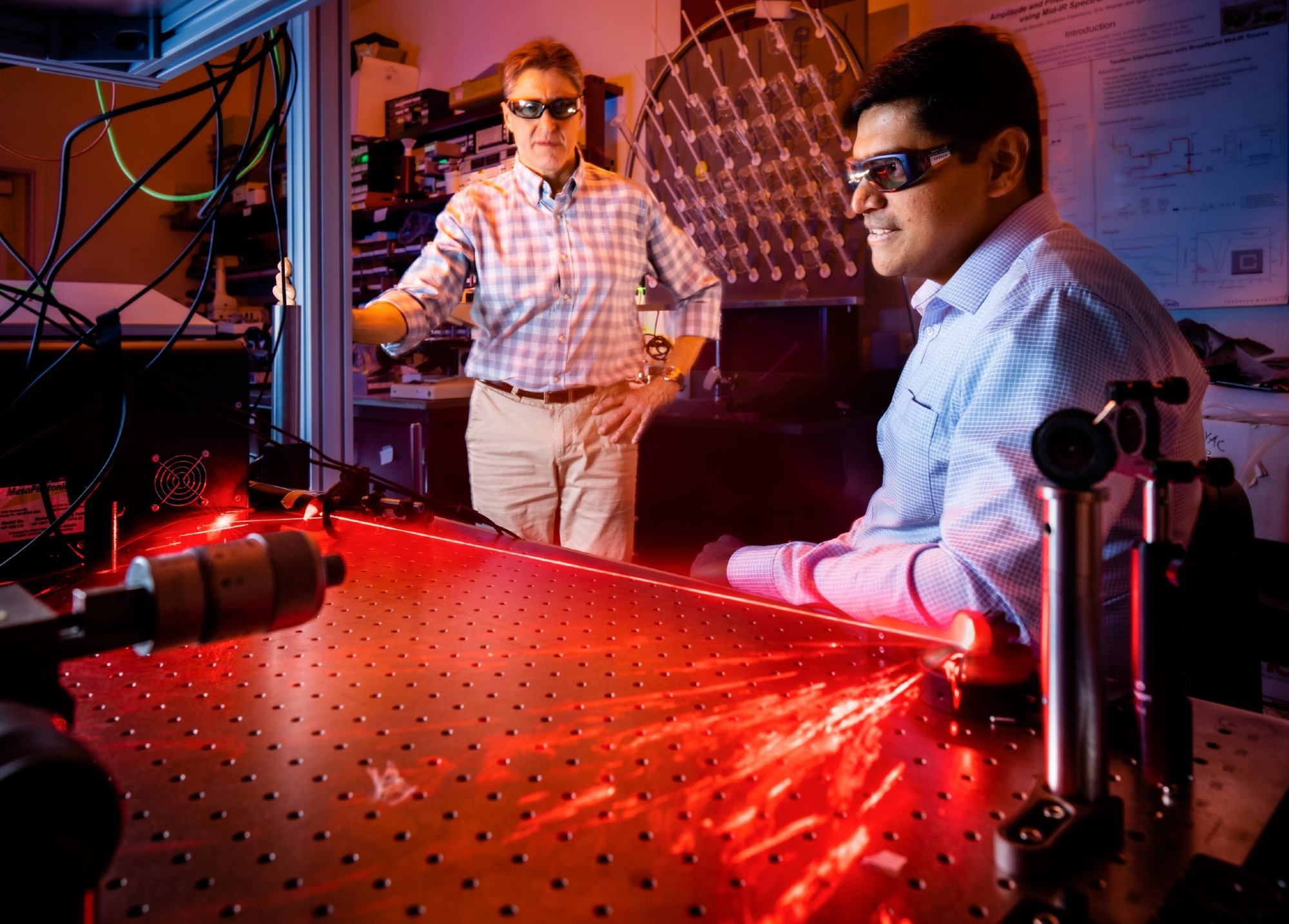A Sandia National Laboratories research team has successfully demonstrated the ability to dynamically direct light pulses from conventional, so-called incoherent light sources, marking a significant advancement in the fields of nanophotonics and ultrafast optics.

As a red beam of light is reflected in an arch, Prasad Iyer, right, and Igal Brener demonstrate optical hardware used for beam steering experiments at Sandia National Laboratories’ Center for Integrated Nanotechnologies. Image Credit: Craig Fritz
By utilizing a semiconductor device to regulate light, it could be possible to substitute more potent laser beams in emerging technologies like holograms, remote sensing, self-driving vehicles, and high-speed communication with low-cost, low-power sources like LEDs or flashlight bulbs.
What we have done is show that steering a beam of incoherent light can be done.
Prasad Iyer, Study Lead Author and Scientist, Sandia National Laboratories
The study’s findings were published in the most recent edition of Nature Photonics. The Office of Science of the Department of Energy provided funding for the study.
Several common sources, such as an LED bulb or an incandescent light bulb, generate incoherent light. Due to the random and varied wavelengths of the photons that are released, this light is referred to as incoherent. However, since all of the photons in a coherent light beam have the same frequency and phase, it does not diffuse and spread like a laser beam.
In their study, the group used artificially structured materials called metasurfaces, which are built from small semiconductor building pieces called meta-atoms and can be engineered to reflect light very effectively.
The fact that meta surfaces had only been created for coherent light sources presented a problem, despite the fact that they had previously shown promise for creating devices that could direct light beams at any angle.
The ideal semiconductor device would be able to emit light like an LED, direct the light emission to a certain angle by using a control voltage, and quickly change the steering angle.
The researchers began with a semiconductor metasurface that included quantum dots, which are incredibly tiny light sources. This is a remarkable achievement since they were able to guide the light waves released from the quantum dots in different directions over a 70-degree range for less than a trillionth of a second by utilizing a control optical pulse.
The steered beam created brilliant light at a distance instead of allowing incoherent light to spread over a larger viewing angle, similar to laser-based steering.
Taming Light
The team’s proof-of-principle work opens the door for advancements in the fields of nanophotonics and ultrafast optics, a feat that was previously thought to be unattainable. Countless applications are possible when incoherent light sources can be dynamically controlled and their attributes tweaked.
Brightening military helmet screens that show maps or blueprints over the user’s normal field of vision might be one low-power use.
Iyer added, “In applications where space is valuable steering light emission with low-size-and-weight metasurface-LED displays could be made possible in the future with this technology. We can use the light emitted in a better way rather than just turning them off and on.”
A new type of small display that can project holographic images onto the eyes using low-power LEDs could also be made possible by the technique; this feature is especially appealing for augmented and virtual reality applications. LIDAR can also be employed in autonomous vehicles to detect things in the path of the vehicle.
In terms of expressions of interest, the team has received multiple inquiries from commercial sources, according to Sandia researcher Igal Brener, a study author and project lead scientist.
A commercial product could be 5–10 years out, especially if we want to have all the functionality on-chip. You wouldn’t use a control optical pulse to impart the changes in the metasurface needed to steer the light, but rather you would do this control electrically. We have ideas and plans, but it is still early.
Igal Brener, Study Author and Lead Scientist, Sandia National Laboratories
Brener further stated, “Imagine an LED light bulb that can emit light to follow you. Then you wouldn’t waste all that illumination where there is nobody. This is one of the many applications that we dreamed about with DOE years ago for energy efficiency for office lighting, for example.”
Similar to this, tamed light could eventually be useful in situations like surgery or autonomous vehicles when focused illumination is only required in a certain area of interest.
The future appears promising for coherent light.
Journal Reference
Iyer, P. P., et al. (2023) Sub-picosecond steering of ultrafast incoherent emission from semiconductor metasurfaces. Nature Photonics. doi:10.1038/s41566-023-01172-6.